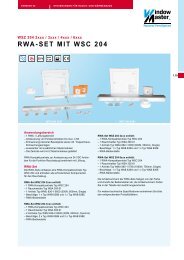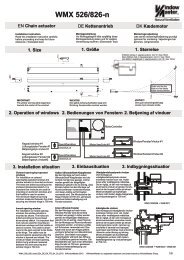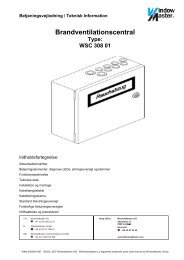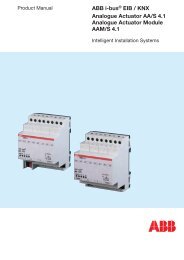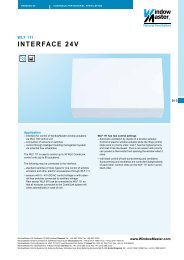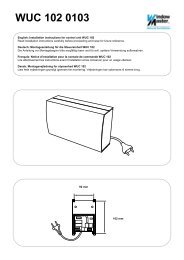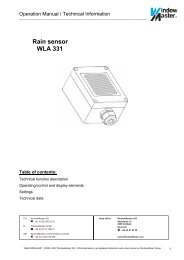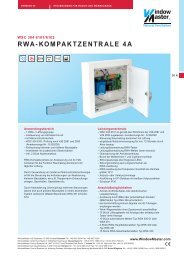ABB i-bus® EIB Universal Interfaces US/U 4.2 US/U ... - WindowMaster
ABB i-bus® EIB Universal Interfaces US/U 4.2 US/U ... - WindowMaster
ABB i-bus® EIB Universal Interfaces US/U 4.2 US/U ... - WindowMaster
You also want an ePaper? Increase the reach of your titles
YUMPU automatically turns print PDFs into web optimized ePapers that Google loves.
<strong>ABB</strong> i-bus ® <strong>EIB</strong><br />
<strong>Universal</strong> <strong>Interfaces</strong><br />
<strong>US</strong>/U 2.2, GH Q631 0074 R0111<br />
<strong>US</strong>/U <strong>4.2</strong>, GH Q631 0070 R0111<br />
Control the scene via “8 bit scene”<br />
Parameter value<br />
“on long operation”<br />
“if object value = 1”<br />
“on long operation<br />
(if object value = 1)”<br />
Behaviour<br />
After a long operation, the object “8 bit scene” sends a save<br />
command on the bus and thereby triggers the storing of the<br />
current scene in the actuators.<br />
The object “Store scene” has no function.<br />
If the object “Store scene” receives the value “1”, the object<br />
“8 bit scene” sends a save command on the bus.<br />
If the object “Store scene” receives the value “1” on the bus,<br />
the next long push button action triggers the sending of<br />
a save command via the object “8 bit scene”.<br />
Provided that a “1” has not been received at the object “Store<br />
scene” since the last save, a long operation is interpreted in<br />
the same way as a short operation. The same applies if the<br />
value “0” has been received.<br />
Parameter: “Long operation after”<br />
This parameter is visible if the saving of the scene is possible via a long<br />
operation. The period is defined here, after which an operation is interpreted<br />
as “long”.<br />
Parameter: “Debounce time”<br />
The debounce prevents unwanted multiple operation of the input e.g. by<br />
bouncing of the contacts. Refer to section 5.1 for the exact function of this<br />
parameter.<br />
Parameter window: “A-Scene”<br />
This parameter window is visible if the control of the lightscenes is carried out<br />
via “5 separate objects”.<br />
Parameter: “Control of actuator group A…E via”<br />
It can be set for each actuator group whether the control is carried out<br />
via a “1 bit object” or an “8 bit object”. The type of the communication object<br />
“Telegr. switch/value actuator group A…E” is set accordingly.<br />
Parameter: “Preset value actuator group A…E”<br />
A value is preset for each actuator group A…E in this parameter. If a scene<br />
has been stored, the current object values of actuator groups A…E are overwritten<br />
with the values set here following programming or bus voltage recovery<br />
and when the scene is recalled again.<br />
4.8.2 Communication objects<br />
Object: “Telegr. switch actuator group A … E”, 1 bit (EIS 1) or<br />
“Telegr. value actuator group A … E”, 8 bit (EIS 6)<br />
These objects are visible if the scene is controlled via “5 separate objects”.<br />
They control several actuator groups, either via 1 bit or 8 bit values (can be<br />
parameterised). When storing the scene, the device reads out the current<br />
value via the bus and stores it in these objects.<br />
On bus voltage recovery, the object values are overwritten with the parameterised<br />
values.<br />
25



